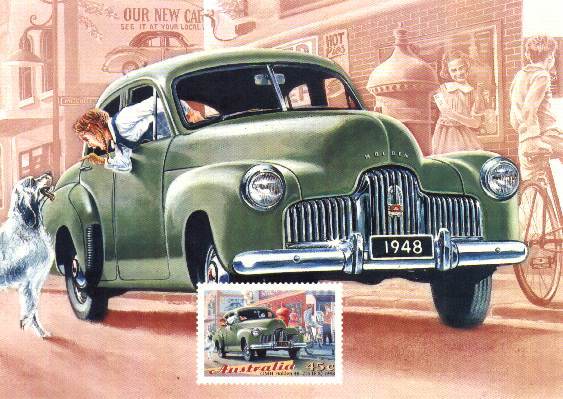
Home
Dad's Army Unit
& Associated Stuff
Soldier Settlement - the who, what and where?
Ditties for you to read
Send a CooEE!!

Ruffus Page
From the moment the Holden 48-215, the FX, rolled out of the GM-H plant at Fisherman's Bend in Melbourne in November 1948, the proud "baby" of Prime Minister Ben Chifley, it was destined to become part of Australian folklore and legend .... and a symbol of national pride.
Though based loosely upon an American design, this all new six-cyclinder, six seated sedan would soon become Australia's first successfully mass-produced car. The first Holden.
Yet the road to that landmark launch of Australia's first car had not been an easy one, and attempt to produce an all Australian car can be traced back to at least the 1890's......
Although this was probably the first car driven by an internal combustion engine to run in Australia, it can hardly be classed as a successful vehicle since it is reported to have been prone to burst into flames and never progressed further than the length of a single street.
Two years later, however, Highland built a new car using a De-Dion engine, and this appears to have run successfully for a considerable period.
There were others, in Victoria, Captain Harley Tarrant and Harold Lewis constructed the first entirely Australian-made petrol-driven vehicle in 1899. This however, was a two-cyclinder chain-driven car and, like Highland's effort in Annandale, it was not very successful.
All during these years Australians who could afford the new-fangled horseless carriages relied solely upon overseas imports.
Later during the 1920's some more attempts were made to roduce an Australian car. Among these models were the Australian Six, the Summit, the Eco, the Wege, and the Reo, but sadly none of these small enterprises survived the depression years of the early 1930's.
However, in 1931 General Motors Australia Pty Ltd amalgamated with Holden's Motor Body Builders to form a new company called General Motors-Holden's Ltd, which in 1945 undertook an agreement with the Commonwealth Government to develop an Australian car for mass production.
The big day came on 29th November, 1948 at a gala ceremony at Fisherman's Bend when the Prime Minister, Ben Chifley, a man who had done so much for the project, officially launched the new Holden.
It was an immediate hit with the Australian public. Powered by a strond performing 2.15 litre engine, with a three-speed manual gearbox and weighing less than a tonne, the car received rave reviews throughout the land. In those early days wherever the 48-215 went it drew a crowd, with weary drivers having to continually answer the same question from keen questioners: "How does she run?"
The new Holden was popular too, in both the city and the country. It's designers had paid particular attention to the rugged Australian conditions, and the car was well-liked by farmers. For tradesman and many on the land, however, the utility model proved espically popular.
The 48-215 remained on sale from November, 1948 through to October 1953, before being superseded by the FJ model. By the end of its long run, which saw over 120,00 units produced, it was available in Sedan, Utility and Business Sedan forms.
The FX Holden occupies a special place in Australian motoring history. Not just because it was the first Holden and Australia's first successfully mass-produced motor vehicle, but also because it was both a source and a symbol of national pride. Espically for those many, many thousands of Australian families who took the big 733 pounds plunge into ownership.
